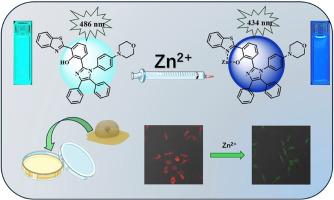A highly sensitive fluorescent probe for the detection of Zn2+ based on benzothiazole and triarylimidazole derivatives with AIEE effect
IF 4.2
3区 工程技术
Q2 CHEMISTRY, APPLIED
引用次数: 0
Abstract
Zinc ions (Zn2+) are indispensable and play an important role in biological, environmental, and industrial system, and it is extremely significant to monitor effectively the concentration of Zn2+ in biological and environmental field. Herein, we developed a new fluorescent probe named as FBTZ-IMZ with AIEE bearing benzothiazole group and triarylimidazole unit. FBTZ-IM displayed excellent selectivity and sensitivity toward Zn2+ in ethanol with a significant blue shift in emission. Under 365 nm UV light irradiation, the fluorescence color of FBTZ-IMZ solution varied from cyan to blue in the presence of Zn2+. The binding stoichiometry and mechanism were explored via Job's plot analysis, 1H NMR, HRMS and DFT calculations. The proposed sensing mechanism was confirmed by the inhibition of ESIPT and the activation of CHEF effect. The limit of detection and binding constant for Zn2+ were determined to be 28 nM and 1.2 × 106 M−1, respectively. Importantly, probe FBTZ-IMZ has fast response time, wide pH tolerance and strong anti-interference ability. In addition, FBTZ-IMZ was successfully applied for bioimaging of Zn2+ in live cells owing to its high sensitivity, excellent cell membrane penetrability and low cytotoxicity.

具有AIEE效应的苯并噻唑和三芳基咪唑衍生物的高灵敏度Zn2+荧光探针
锌离子(Zn2+)在生物、环境和工业系统中不可或缺,发挥着重要作用,有效监测Zn2+浓度在生物和环境领域具有极其重要的意义。在此,我们开发了一种新的荧光探针,命名为FBTZ-IMZ, AIEE含有苯并噻唑基团和三芳咪唑单元。FBTZ-IM对乙醇中Zn2+具有良好的选择性和敏感性,发光蓝移明显。在365 nm紫外光照射下,Zn2+存在下,FBTZ-IMZ溶液的荧光颜色由青色变为蓝色。通过Job’s plot分析、1H NMR、HRMS和DFT计算,探讨了其结合化学计量学和机理。该传感机制通过抑制ESIPT和激活CHEF效应得到证实。Zn2+的检出限为28 nM,结合常数为1.2 × 106 M−1。重要的是,探针FBTZ-IMZ具有响应时间快、耐pH值宽、抗干扰能力强的特点。此外,FBTZ-IMZ因其高灵敏度、优异的细胞膜穿透性和低细胞毒性,成功应用于活细胞中Zn2+的生物成像。
本文章由计算机程序翻译,如有差异,请以英文原文为准。
求助全文
约1分钟内获得全文
求助全文
来源期刊

Dyes and Pigments
工程技术-材料科学:纺织
CiteScore
8.20
自引率
13.30%
发文量
933
审稿时长
33 days
期刊介绍:
Dyes and Pigments covers the scientific and technical aspects of the chemistry and physics of dyes, pigments and their intermediates. Emphasis is placed on the properties of the colouring matters themselves rather than on their applications or the system in which they may be applied.
Thus the journal accepts research and review papers on the synthesis of dyes, pigments and intermediates, their physical or chemical properties, e.g. spectroscopic, surface, solution or solid state characteristics, the physical aspects of their preparation, e.g. precipitation, nucleation and growth, crystal formation, liquid crystalline characteristics, their photochemical, ecological or biological properties and the relationship between colour and chemical constitution. However, papers are considered which deal with the more fundamental aspects of colourant application and of the interactions of colourants with substrates or media.
The journal will interest a wide variety of workers in a range of disciplines whose work involves dyes, pigments and their intermediates, and provides a platform for investigators with common interests but diverse fields of activity such as cosmetics, reprographics, dye and pigment synthesis, medical research, polymers, etc.
 求助内容:
求助内容: 应助结果提醒方式:
应助结果提醒方式:


